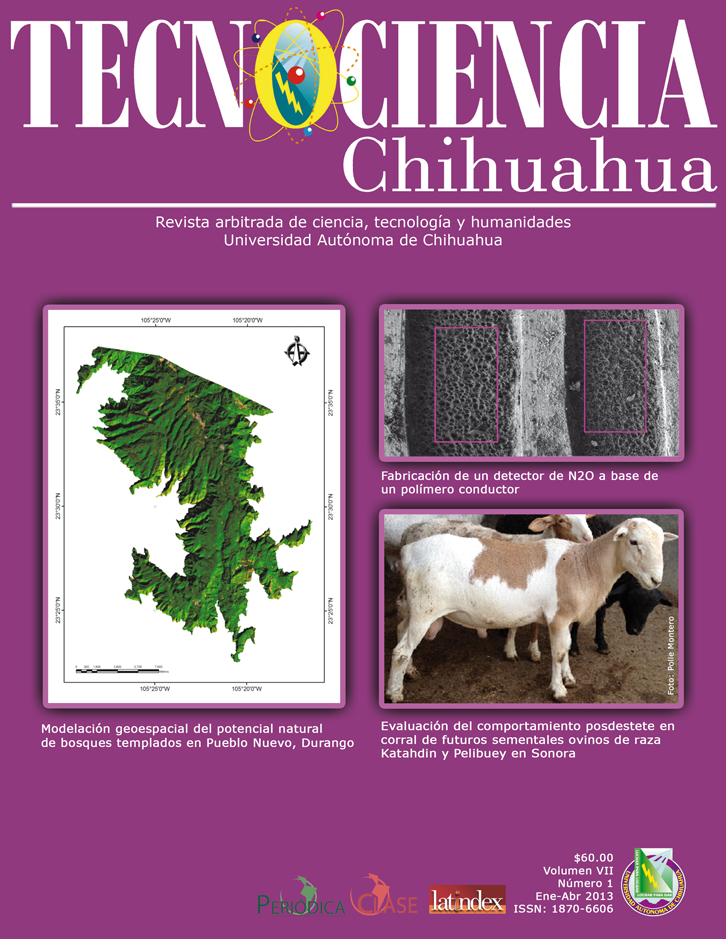Tendencias del procesamiento computacional: bioinformática y cómputo ubicuo
Trends in computational processing: bioinformatics and ubiquitous computing
Resumen
Desde sus inicios, la computación ha sido una herramienta eficaz y popular para la resolución de problemas de distinta índole y niveles de complejidad. Los usos que la computadora ha tenido van desde operación de editores de texto y hojas de cálculo hasta procesamiento intensivo a través de computadoras interconectadas que buscan dar solución a problemas con un gran número de variables. Las tendencias del procesamiento computacional han estado ligadas a los avances en diversas áreas de la ciencia, creando una simbiosis que motiva diseños más eficientes de cómputo y a la vez hace posible extender los límites del conocimiento. Dos áreas que han explotado el procesamiento computacional buscando elevar la calidad de vida de la sociedad son la bioinformática y el cómputo ubicuo. Las aportaciones de cada una de estas líneas son evidentes, aún así creemos que lo mejor de ambas está por venir.
Abstract
Since its beginnings, the computing has been an efficient and popular tool for solving problems of different kinds and levels of complexity. The uses of computers range from text editors and spreadsheet programs to intensive processing via computer clusters that seek to tackle problems with a big number of variables. The trends in the computational processing have been linked to advances in the sciences, creating a symbiosis that motivates more efficient computing designs as well as to increase the knowledge. Two main areas that have exploited the computational processing to achieve a better life quality in our society are the bioinformatics and ubiquitous computing. The contributions made by each of these areas are evident, even though the best of both is yet to come.
Keywords: information processing, computational biology, context awareness, human-computer interaction.
Citas
Abburu, S. 2012. A survey on ontology reasoners and comparison. International Journal of Computer Applications 57(17). https://www.ijcaonline.org/archives/volume57/number17/9208-3748
Aguirre, D. 2015. Cognitive Computing [Material de Clase]. Colección personal de Diego Aguirre.
Aguirre, D. 2015. JSON – Watson Tutorial [Material de clase]. Colección personal de Diego Aguirre.
Amini, R. 2015. EC3 Fieldtrip: 2-7 August 2015. Yosemite NP and Owens Valley.
Barahmand, S., M.Taheryian, S. Al-Ashri & B. Upadhyay. 2010. A Survey on SWEET Ontologies and their applications.
Barnaghi, P., W. Wang, C. Henson & K. Taylor. 2012. Semantics for the Internet of Things: early progress and back to the future. International Journal on Semantic Web and Information Systems (IJSWIS) 8(1): 1-21. https://doi.org/10.4018/jswis.2012010101
Berners-Lee, T. & J. Hendler. 2001. Publishing on the semantic web. Nature 410:1023-1024. https://doi.org/10.1038/35074206
Berners-Lee, T., J. Hendler & O. Lassila. 2001. The Semantic Web. Scientific American 284(5), 28-37. https://tinyurl.com/3xfv5wxh
Cognitive Computing Consortium. 2014. Cognitive Computing defined.
Cognitive Computing Consortium. 2016. HPE Haven OnDemand Machine Learning & Search.
Dumontier, M. & N. Villanueva-Rosales. 2009. Towards pharmacogenomics knowledge discovery with the semantic web. Briefings in bioinformatics 10(2):153-163. https://doi.org/10.1093/bib/bbn056
Ferrucci, D. 2012. Introduction to This is Watson. IBM Journal of Research and Development 56(3.4). https://ieeexplore.ieee.org/document/6177724
Ferrucci, D., E. Brown, J. Chu-Carroll, J. Fan, D. Gondek, A. A. Kalyanpur & A. Lally. 2010. Building Watson: An overview of the DeepQA project. AI Magazine 31(3):59-79. https://doi.org/10.1609/aimag.v31i3.2303
Fu, J., A. Gucalp, M. Glass, A. S. Epstein, M. G. Kris, J. Keesing, A. Caroline, M. Megerian, T. Eggebraaten, R. DeLima, M. Setnes, P. Wildt & A.D. Seidman. 2015. Steps in developing Watson for Oncology, a decision support system to assist physicians choosing first-line metastatic breast cancer (MBC) therapies: Improved performance with machine learning. ASCO Annual Meeting I. https://ascopubs.org/doi/10.1200/jco.2015.33.15_suppl.566
Fuchs, C., W. Hofkirchner, M. Schafranek, C. Raffl, M. Sandoval & R. Bichler. 2010. Theoretical foundations of the web: cognition, communication, and co-operation. Towards an understanding of Web 1.0, 2.0, 3.0. Future Internet 2(1):41-59. https://doi.org/10.3390/fi2010041
Gil, Y., M. Chan, B. Gomez & B. Caron. 2014. EarthCube: Past, Present, and Future. EarthCube Project Report EC-2014-3.
Hitzlet, P., M. Krotzsch & S. Rudolph. 2009. Foundations of the Semantic Web Technologies. Chapman & Hall. ISBN 9781420090505.
Hoendorf, R., M. Dumontier & G. V. Gkoutos. 2012. Evaluation of research in biomedical ontologies. Briefings in bioinformatics 14(6):696-712. https://doi.org/10.1093%2Fbib%2Fbbs053
IBM. 2014. IBM Watson: How it works.
IBM. 2016. IBM Watson for Oncology.
IBM Security. 2016. Cognitive security.
Jackson, J. 2011. IBM Watson vanquishes human Jeopardy foes. PC World. https://tinyurl.com/y3rwy58m
Mookerjee, M., D. Vieira, M. A. Chan, Y. Gil, C. Goodwin, T. F. Shipley & B. Tikoff. 2015. We need to talk: Facilitating communication between field-based geoscience. GSA Today 25(11):34-35. https://doi.org/10.1130/GSATG248GW.1
Mookerjee, M., D. Vieira, M. A. Chan, Y. Gil, T. L. Pavlis, F. S. Spear & B. Tikoff. 2015. Field data management: Integrating cyberscience and geoscience. Eos 96(20): 18-21. https://eos.org/science-updates/field-data-management-integrating-cyberscience-and-geoscience
Ontotext. 2014. The Truth About Triplestores. The top 8 things you need to know when considering a Triplestore. Ontotext. https://files.stample.co/browserUpload/b16a69c6-522b-40db-a192-7bc859118e40
Raskin, R. & M. Pan. 2005. Semantic web for earth and environmental terminology (SWEET). Proc. of the Workshop on Semantic Web Technologies for Searching and Retrieving Scientific Data. https://tinyurl.com/2p8nkjn4
Robinson, I., J. Webber & E. Eifrem. 2015. Graph Databases: New Opportunities for Connected Data. O'Reilly Media, Inc. ISBN 1491930896, 9781491930892.
Royo-León, M., L. M. Rodriguez, P. Gallardo, T. Gonzalez, R. Negron, D. Aguirre & O. Fuentes. 2016. SEXWISE: An IBM Watson-Powered Mobile Application to Promote Sexual Education. En Tecnologías emergentes y avances de la computación en México – ENC 2016 (pp. 205-210). http://dx.doi.org/10.13140/RG.2.2.10123.69923
Russell, S. & P. Norvig. 1995. Artificial Intelligence: A modern approach. Natural language question-answering systems. Communications of the ACM 13(1):15-30.
Unocero. 2017. IBM Watson llega al Museo de Antropología. https://www.unocero.com/noticias/ciencia/ibm-watson-en-museo-antropologia/
Villanueva-Rosales, N., R. Long, A. Gates, N. Rivera, O. Mondragon, S. Cabrera, C. Ferregut, C. Carrasco, S. Nazarian, H. Taboada, V.M. Larios, L. Barbosa-Santillan, M. Svitek, O. Pribyl, T. Horak & D. Prochazkova. 2015. A collaborative, interdisciplinary initiative for a smart cities innovation network. En IEEE First International Conference On Smart Cities (pp. 1-2). IEEE. http://dx.doi.org/10.1109/ISC2.2015.7366179
Derechos de autor 2020 TECNOCIENCIA Chihuahua

Esta obra está bajo licencia internacional Creative Commons Reconocimiento-NoComercial 4.0.







